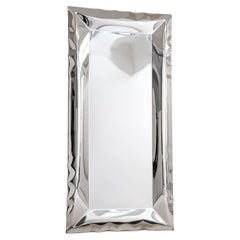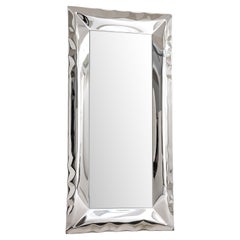Ghost Inflated Metal Full Length Mirror
21st Century and Contemporary British Modern Floor Mirrors and Full-Leng...
Metal, Steel, Stainless Steel
21st Century and Contemporary British Modern Floor Mirrors and Full-Leng...
Metal, Steel, Stainless Steel
Recent Sales
21st Century and Contemporary British Modern Floor Mirrors and Full-Leng...
Metal, Steel, Stainless Steel
21st Century and Contemporary British Modern Floor Mirrors and Full-Leng...
Metal, Stainless Steel, Steel
People Also Browsed
Antique 15th Century and Earlier African Natural Specimens
Bone
2010s German Mid-Century Modern Chandeliers and Pendants
Brass
21st Century and Contemporary Italian Modern Wall Mirrors
Metal
21st Century and Contemporary Portuguese Modern Wall Mirrors
Mirror, Lacquer
Vintage 1970s Swiss Mid-Century Modern Sofas
Leather
21st Century and Contemporary French Brutalist Night Stands
Oak
21st Century and Contemporary Portuguese Beds and Bed Frames
Cotton, Wood
Vintage 1970s Italian Mid-Century Modern Sectional Sofas
Metal
2010s Italian Side Tables
Onyx
21st Century and Contemporary Spanish Minimalist Side Tables
Marble, Travertine
2010s American Ottomans and Poufs
Wool, Jute
21st Century and Contemporary French Coffee and Cocktail Tables
Steel
2010s Australian Modern Side Tables
Glass, Lacquer
Mid-20th Century Finnish Mid-Century Modern Dining Room Sets
Birch
Vintage 1920s Dutch Art Deco Chairs
Fabric, Birch
2010s French Mid-Century Modern Armchairs
Fabric, Wood
A Close Look at Modern Furniture
The late 19th and early 20th centuries saw sweeping social change and major scientific advances — both of which contributed to a new aesthetic: modernism. Rejecting the rigidity of Victorian artistic conventions, modernists sought a new means of expression. References to the natural world and ornate classical embellishments gave way to the sleek simplicity of the Machine Age. Architect Philip Johnson characterized the hallmarks of modernism as “machine-like simplicity, smoothness or surface [and] avoidance of ornament.”
Early practitioners of modernist design include the De Stijl (“The Style”) group, founded in the Netherlands in 1917, and the Bauhaus School, founded two years later in Germany.
Followers of both groups produced sleek, spare designs — many of which became icons of daily life in the 20th century. The modernists rejected both natural and historical references and relied primarily on industrial materials such as metal, glass, plywood, and, later, plastics. While Bauhaus principals Marcel Breuer and Ludwig Mies van der Rohe created furniture from mass-produced, chrome-plated steel, American visionaries like Charles and Ray Eames worked in materials as novel as molded plywood and fiberglass. Today, Breuer’s Wassily chair, Mies van der Rohe’s Barcelona chair — crafted with his romantic partner, designer Lilly Reich — and the Eames lounge chair are emblems of progressive design and vintage originals are prized cornerstones of collections.
It’s difficult to overstate the influence that modernism continues to wield over designers and architects — and equally difficult to overstate how revolutionary it was when it first appeared a century ago. But because modernist furniture designs are so simple, they can blend in seamlessly with just about any type of décor. Don’t overlook them.
Finding the Right Floor-mirrors-full-length-mirrors for You
Bringing antique and vintage floor mirrors and full-length mirrors into your home is a no-brainer. The right mirror in the bedroom, bathroom and by the door in your home’s entryway — for last-minute accessorizing, of course — can make all the difference.
However, knowing where to strategically place your mirror can help illuminate your interior design choices and add a glamorous accent to any room.
A large beveled floor mirror can add depth to a space — particularly if you’re working with small rooms. It can echo the contour lines of wall paneling and make a bedroom appear larger than it is. Both floor mirrors and full-length mirrors create a window-like effect, reflecting light and brightening the room. Hanging a large mirror opposite a window will flood a room with natural light and engender a feeling of spaciousness.
Consider the placement of a mirror in the room: Displaying vases, boxes and other decorative objects in front of a mirror reflects these items, drawing attention to a prized collection and emphasizing their visual qualities for dramatic effect.
A large antique wall mirror or celebrated iconic design such as Paul Evans’s Patchwork mirror or the flashy, sensuous Ultrafragola mirror created by Ettore Sottsass can be positioned as the focal point in a living room or dining room.
When your mirror isn’t the star of the show, it can be used to enhance a focal point. Hang abstract art — a grouping of paintings or drawings, perhaps — on the wall opposite the mirror to establish narrative character in a space and create an intriguing color pattern.
It is important to consider the size, shape and frame of a mirror. Most full-length mirrors have a traditional rectangular shape, but postmodern mirrors may offer more variety. For a mirror that makes a bold statement, Art Deco mirrors typically feature geometrically pronounced frames that stand out in a room.
Add light to your interiors while providing an artistic accent to any room. Browse the selection of antique and vintage floor mirrors and full-length mirrors on 1stDibs today.



